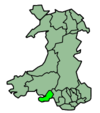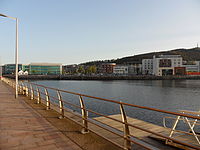- Swansea docks
-
Swansea Docks is the collective name for several docks in Swansea, Wales. The Swansea docks are located immediately south east of Swansea city centre. In the mid-19th century the port was exporting 60% of the world's copper from factories situated in the Tawe valley.[1] The working docks area today is owned and operated by Associated British Ports as the Port of Swansea and the northern part around the Prince of Wales Dock is undergoing re-development into a new urban area branded the SA1 Swansea Waterfront.
Contents
Docks
Docks which have existed or still exist in the complex include:[2]:
North Dock
The North Dock was created to fulfil the increasing shipping demands from the nearby metals industry. The North Dock was created by diverting the River Tawe by cutting a new direct course within a meander section near the estuary. The old course of the River became the new dock and work was completed in 1852.[3] The North Dock closed in 1930 after the development of new larger docks on the east side of the River Tawe made the North Dock obsolete. The north dock has since been filled in and the Parc Tawe retail complex was built on the site in the late 1980s.
South Dock
Construction began on the South Dock in 1852 by a private company. It was built on a site west of the River Tawe, just south of the North Dock and was not completed until 1859.[3] The South Dock was closed in 1971[3] and was redeveloped in the 1980s. The dock itself became the Swansea Marina and the land around the dock was developed as the Maritime Quarter residential area.
Prince of Wales Dock
The Swansea Harbour Trust began constructing the Prince of Wales Dock in 1879 on the site of what was Fabian's Bay to the east of the River Tawe. Once construction work was completed, the Prince of Wales dock was opened on 18 October 1881 by Edward, Prince of Wales. The Prince of Wales Dock was further extended in 1898 to the size the dock currently remains of 27 acres (110,000 m2).[3][4] Usage of the Prince of Wales dock declined throughout the later half of the 20th century. The Prince of Wales Dock is now undergoing redevelopment as the Prince of Wales Marina with 500 berths. An new channel with sea lock and holding basin is currently under construction to link the Price of Wales Dock directly with the River Tawe.[5] A new Wakeboarding facility opened in the Price of Wales Dock in 2010.[6]
King's Dock
Work began on the King's Dock in 1905 to meet the growing demand of Tinplate exports from the local area. The King's Dock was constructed as a much larger dock than the Prince of Wales on south side of the Prince of Wales Dock and covers some 72 acres (.29 km2).[7] Construction was complete by 1909.[3] The King's Dock is the principal dock in the Port of Swansea which is still in use today for cargo operations.
Queen's Dock
At the same time the King's dock was being built, a breakwater was constructed further south of the King's dock which enclosed a large body of water covering some 151 acres (.61 km2).[7] This body of water was to later be opened as the Queen's Dock in 1920 after oil handling facilities were built to handle oil imports for the nearby BP oil refinery at Llandarcy and petrochemical plant at Baglan Bay.[2][3] Usage of the Queen's Dock reached its peak in the 1950s when oil imports and exports reached around 8 million tonnes per year. Since the closure of the oil plants at Baglan Bay and Llandarcy, the Queen's Dock was rendered obsolete and is now little used today.
History
Increases in industrial output and in trade in copper, zinc, iron and tinplate combined with the developments in shipping (whereby steamships of greater tonnage were replacing smaller sailing vessels) meant that by the late 19th century Swansea's harbour was in desperate need of expansion. The Swansea Harbour Trust (SHT) commissioned the construction of the Prince of Wales Dock, the first on the east side of the river. Opened in 1881 by the Prince & Princess of Wales (later Edward VII and Queen Alexandra), it was not completed until 1882. An additional expansion occurred in 1898. The North Quay frontage was let to the Great Western Railway, the Neath and Brecon Railway and the Rhondda and Swansea Bay Railway company, which linked the Dulais Valley and Rhondda Valley coalfields directly with the docks.[8] In addition to shunting locomotives operated by the SHT, further engines were provided by Powlesland and Mason from 1903 onwards.
Port of Swansea
The Port of Swansea is an Atlantic shipping port operated by Associated British Ports which comprises the King's Dock, Queen's Dock, two dry docks and a roll on/roll off ferry terminal in the River Tawe.[9]
Port facilities
The port has three transit sheds with 25,000 m2 (270,000 sq ft) of storage space, 17 quayside cranes, two drydocks, a roll-on/roll-off berth and container terminal.[10] It offers warehouses and facilities for handling dry bulks, minerals, ores, forest products and general cargo.[11]
Ferry services
There is a roll on/roll off ferry terminal in the western part of the docks. Between 1987 and 2006, a regular passenger and car ferry to Ringaskiddy in County Cork, Ireland departed from here. The ferry was operated by a company called Swansea Cork Ferries. The ferry service was suspended from 2007[12] A website and online campaign / e-petition was started in an attempt to highlight the effect that the loss of the Swansea Cork ferry was having on Swansea and the South-West of Ireland.[13] In April 2009, a newly formed co-operative purchased a new vessel to provide a service between Swansea and County Cork. This new ferry service will commence on 10 March 2010.[14]
Ayr · Barrow · Barry · Cardiff · Fleetwood · Garston · Goole · Port of Grimsby · Hams Hall Distribution Park · Port of Hull · Port of Immingham · Ipswich dock · King's Lynn · Lowestoft · Newport · Plymouth · Port Talbot · Tilbury Container Services · Silloth · Port of Southampton · Swansea · Teignmouth · Troon ·
Future plans
In written evidence presented to the Welsh Assembly's Enterprise and Learning Committee in January 2008, Swansea University stated that it was "at an advanced stage of discussion" about a new 'Innovation Campus' on a second site.[15] On 20 March 2008, the university announced that it would conduct a more detailed examination and feasibility assessment of a 100-acre (0.40 km2) site off Fabian Way, covering an area from the docks and the former BP plant to the Site of Special Scientific Interest at Crymlyn Bog.[16] The new campus could be home to Engineering, Computing, Telecommunications, the Business and Law Schools and a range of offices for large and small companies.
References
- ^ The Image Engineers of Swansea
- ^ a b GENUKI: Swansea Timeline
- ^ a b c d e f Retired Section Swansea Docks - A Brief History of Swansea Dock
- ^ 1911 Encyclopedia Britannica - Swansea
- ^ Lewis and Lewis: Portfolio - SA1 Swansea Sea Locks and Communication Channel
- ^ Wakeboarding craze is set to splash down into Swansea
- ^ a b Hutchisong Encyclopedia article about Swansea
- ^ Prince of Wales Dock - Swansea Heritage Net - History in pictures
- ^ ABP: Port of Swansea Map
- ^ Associated British Ports
- ^ Associated British Ports
- ^ BBC NEWS | Wales | South West Wales | Swansea-Cork ferry is suspended
- ^ Bring Back the Swansea Cork Ferry
- ^ BBC News - Swansea-Cork ferry setting sail
- ^ EL(3)-03-08 : Paper 1 : Evidence to the Committee inquiry into the economic contribution of higher education - Swansea University
- ^ New campus plan unveiled by university
External links
- Port of Swansea
- SA1 Waterfront information about regeneration project
- SA1 Swansea Waterfront
- Technium Swansea
- Swansea Docks Retired Section (contains historical information and old photos about Swansea Docks)
- Campaign to bring back the Swansea Cork Ferry
Transport in Swansea Road M4 motorway · European route E30 ·
A48 road · A483 road · A484 road · A4067 road · A4216 road · A4217 road · A4240 road · A4118 road
Bus First Cymru · Veolia Transport Cymru · Gower Explorer · Swansea Metro · National Express · Swansea bus station · Gorseinon bus stationNational Cycle Network Railway lines Railway stations Air Waterways Sea  Harbours of the UK
Harbours of the UKEngland Wales Barry Docks · Cardiff Docks · Fishguard Harbour · Milford Haven · Newport Docks · Pembroke Dock · Port of Port Talbot · Swansea DocksScotland Northern Irelend Categories:- Geography of Swansea
- Districts of Swansea
- Transport in Swansea
- Buildings and structures in Swansea
- Ports and harbours of Wales
- Celtic Wave ports
- Swansea Bay
- Ports and harbours of the Bristol Channel
Wikimedia Foundation. 2010.

